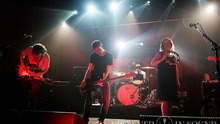Prince Rama’s Top Ten Hits of the End of the World requires a bit of back story. This isn’t surprising, as explaining Taraka and Nimai Larson’s back story has always been necessary. The well touted tale of the sisters growing up on an ashram has been less about building a myth and more about verifying the authenticity of their heavily eastern-influenced, New Agey sound.
Which still doesn’t sound quite so overwrought as making a compilation album of ‘channeled’ (their word) hit songs by bands that died in the, er, apocalypse. It is presented as a Cloud Atlas-styled exercise in genre, but that’s not really how it’s executed. Any nuance is flattened by far too much reverb; it’s uncertain whether that reverb is meant to mimic the degradation of a long-lost cassette or is just part of an aesthetic abused by all those remotely connected to the indie rock world, but either way, it takes something away from the final product.
What it does sounds like is Prince-Rama-make-a-pop-record. Which in all truth is really great; as the top ten hits of an imagined world, these are borderline radio-friendly tunes spun out as a fatalistic dance party. The Larson sister have spent the last four years exploring rhythms and tones outside of western pop and indie rock music. There is something decidedly Middle Eastern about their fake Emirati band, a definite Bollywood vibe from the alleged Indian film stars, and a Kraftwerkian pulse to a Taoist chant by the German architects-turned-monks, all of whom have been conjured up by Prince Rama in glittery diorama.
There’s a visual side of End of the World that is not only stunning, but really necessary to tie things together. The Larson sisters have written stories for these fake bands and dressed for the promo photos, rather similarly to Tori Amos’ Strange Little Girls project. Not to start an argument about the virtues of physical formats, but it completes the concept to have this visual representation of these fictitious bands.
Whether this is an exercise in pastiche or heralding a new direction for Prince Rama, it’s definitely the most accessible record they’ve ever made. The timing of End of the World is unfortunately prescient; the release of the album comes not only a month ahead of Roland Emmerich’s Mayan end of the world, but also just after a devastating hurricane hit Prince Rama’s home town of New York (and a large area surrounding it). The surreality and absurdity of dance music from the apocalypse is a joyful alternative to the surreality and absurdity of disaster movies and real life disasters.
-
7Amanda Farah's Score























